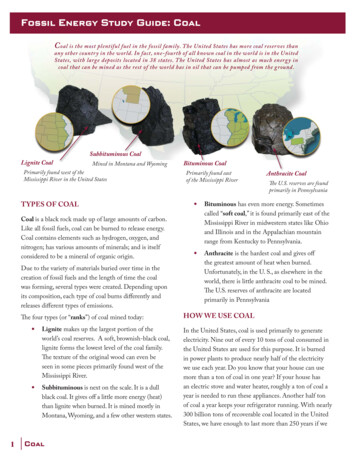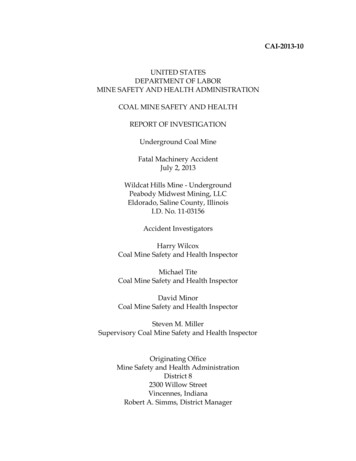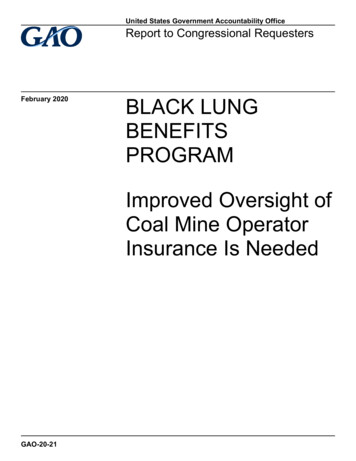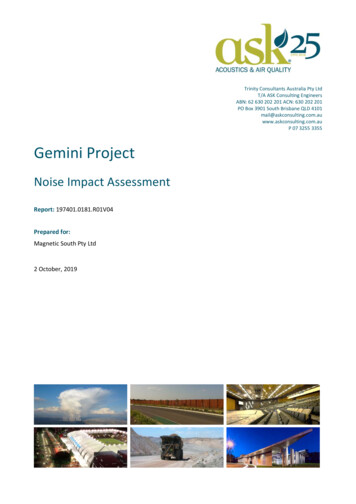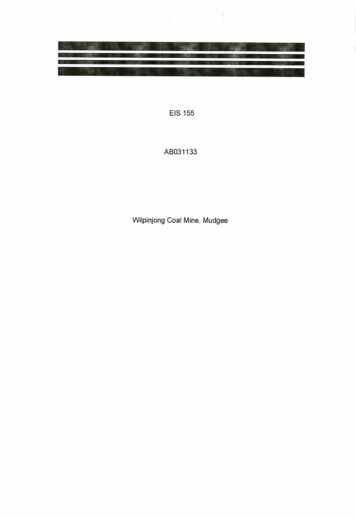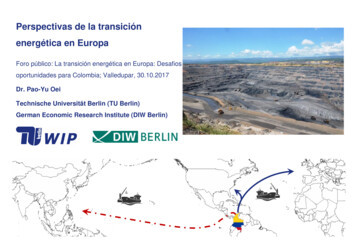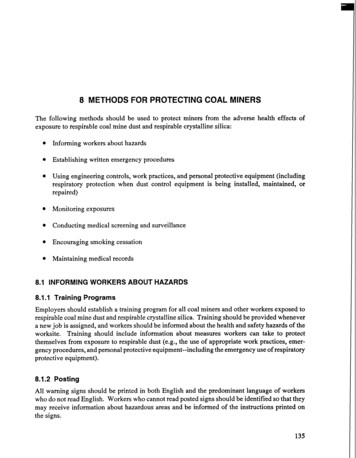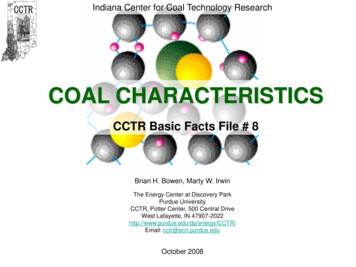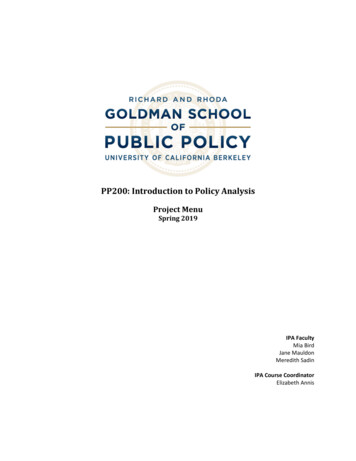
Transcription
Executive Summary
IntroductionNew Acland Coal Pty Ltd (NAC) currently operates the existing New Acland coal mine (the Mine), a4.2 million tonnes (product coal) per annum (Mtpa) open cut coal mine on mining lease (ML) ML 50170 andML 50216 within Mineral Development Licence (MDL) MDL 244, under the approval of EnvironmentalAuthority (EA) No. MIM800317705. The Mine has recently received approval from the Department ofEnvironment and Resource Management (DERM) to mine up to 4.8 Mtpa of product coal through theamendment process outlined under the Environmental Protection Act 1994 (EP Act).The proposal involves the staged expansion of the Mine up to a capacity of 10 Mtpa of product coal throughthe inclusion and progressive development of three new resource areas within MLA 50232 (the Project). TheProject is expected to extend coal production at the Mine until approximately 2042. The Project’s location isshown on Figure 1.The ProponentThe Project Proponent is NAC, which is a fully owned subsidiary of New Hope Corporation Limited (tradingname: New Hope Coal Australia (NHCA)). NHCA purchased the Acland coal reserves from Shell CoalAustralia Ltd in December 1999.NHCA has a highly successful record in the development and management of world-class open cut coaloperations. In Queensland, NHCA manages the New Oakleigh Mine near Ipswich and has coal resources ofover one billion tonnes in Queensland. The New Acland reserve is typical of the Walloon coal measures andis found in a multiple thin seam configuration. The attractive stripping ratios will enable NAC to utilize itsproven expertise in thin seam mining to produce a high quality, low cost domestic and export coal product.Further information concerning the Project can be obtained from:Mr David GennSenior Environmental AdvisorNew Hope Coal AustraliaTelephone (07) 3810 0500Email: dgenn@newhopecoal.com.auFurther information about NHCA can be obtained from: www.newhopecoal.com.auNew Acland Coal Mine Stage 3 Expansion Project – Environmental Impact StatementPAGE 1
(MACKAY !! BUNDABERGBUNDABERG!((ROMA !BRISBANE!(HERVEY BAY!!GYMPIENOOSACHINCHILLA!!KILCOY!ESK !DALBY!JONDARYAN! OAKEY!TOOWOOMBA!GATTONBRISBANE!!IPSWICHGOLD COAST!LEGEND!TownMajor RoadMajor RailwayMajor WaterwayNew Acland Project SiteqFIGURE 1NEW ACLAND STAGE 3COAL MINE EXPANSIONProject Locational Plan0255075KilometresScale 1:1,750,000 on A4Projection: Australian Geodetic Datum 1984I:\QENV2\Projects\QE06455\Spatial\Arc MXD\Figures\ExecSumRpt Figure1 Project Locational Plan.mxd Produced: 26/08/2009.!
Project Need & AlternativesThe coal industry in Queensland employs about 20 000 people directly. A further 70 000 indirect jobs arecreated through the industry’s activities. At full production, the Project will directly employ more than420 people in the later years of operation. Currently, the Mine employs approximately 275 people, with anadditional 169 people required before the maximum production rate of 10 Mtpa can be achieved in 2015.The Project will boost economic activity within the Toowoomba Regional Council (TRC) region of the DarlingDowns through direct and indirect employment, investment and business opportunities for the life of theProject and beyond.The Project offers an opportunity for NHCA to expand its business base, improve profitability and increase itsreturn to shareholders. The Project’s thermal coal products are a valued energy resource that possess lowersulphur, produces less greenhouse emissions and provides a higher energy output than many alternativethermal coal sources. Despite the recent global economic downturn, there is sufficient sustainable demandto support the Project. Demand for power generation capacity is expected to remain relatively strong,particularly in the developing economies of China and India, which are expected to support thermal coal usein the medium to long term.NAC will invest approximately 15 billion over the life of the Project on development, operational, transportand other associated activities. The Project is expected to contribute approximately 105 million per annumto the Gross State Product. The Project will also contribute significantly to the State in rail freight androyalties. This contribution coupled with the direct and indirect employment opportunities and associatedspending, highlights the value of the Project to Queensland.Without the Project proceeding, NAC would be unable to maintain and improve its market share andprofitability. The government would compromise its potential revenue from freight charges and related taxes.Increased employment opportunities would be lost along with potential income for the existing workforce andsupport contractors. Without the Project, an increase in demand for secondary support industries and servicesuppliers would not be realised. Chapter 2 Project Justification and Sustainability provides additionalinformation supporting the need for the Project.Project OverviewThe key elements of the Project are: expansion of the existing mining activities by the addition of the Manning Vale, Willeroo and Sabineresource areas within Mining Lease Application (MLA) MLA 50232, located to the south and west of thecurrent MLs 50170 and 50216; total production up to 10 Mtpa of product coal which equates to approximately 20 Mtpa Run-of-Mine(ROM) Coal; production of 279.7 Mt of product coal over the life of the Project; construction period commencing in 2010 to 2013, initially involving the construction of site access androads (including re-alignments), water management structures and additional supporting infrastructure; maintenance of the existing thin seam coal, open cut mining techniques and expansion of the Mine’struck and loader mining fleet;New Acland Coal Mine Stage 3 Expansion Project – Environmental Impact StatementPAGE 3
addition of a new Coal Handling and Preparation Plant (CHPP(3)), ROM and product coal stockpileareas and supporting infrastructure on MLA 50232; tailings disposal within a series of Tailings Storage Facilities (TSFs) on MLA 50232 comprising an initialengineered out-of-pit TSF followed by in-pit disposal to engineered TSF’s in the back filled mine pits ofthe current and future mine pit areas; construction of a new Raw Water Dam (RWD (3)) to supply CHPP 3; progressive disposal of coarse rejects to cells within the overburden dumps; emplacement of four out-of-pit spoil dumps containing a total material volume of 128.1 Mm 3 associatedwith the Manning Vale, Sabine and Willeroo pits; generation of five potential final voids, comprising 560.1 hectares (ha) within the total area of the Projectequalling 7 347 ha; raw water supply from the Wetalla Wastewater Reclamation Facility (WWRF) from Toowoomba via a45 km pipeline. This project was the subject of a separate Environmental Impact Statement (EIS)process under the State Development & Public Works Organisation Act 1971 (SDPWO Act); a mine surface water management system involving various water management structures staged toaccommodate the progressive development of the Mine. These water management structures will beconstructed to divert clean water and capture and manage mine area runoff and mine pit water forreuse; addition of a new administration and heavy vehicle maintenance area on MLA 50232; relocation and potential upgrade of the power supply to the Project; diversion of the Jondaryan-Muldu Road around the Manning Vale resource area; diversion of Lagoon Creek around the Manning Vale resource area and the progressivere-establishment of Lagoon Creek along its original alignment including rehabilitation of the riparian andin-stream zones; development of a suitable ‘off set’ strategy to satisfy State and Federal requirements for clearance ofsignificant vegetation within new operational areas on MLA 50232; closure of the Acland Township and the relocation of significant historical items to the ‘Acland HeritagePrecinct’ off site for tourism and other commemorative purposes; construction of a new 8 km private haul road as a dedicated transport corridor from the Mine to theJondaryan Rail Loading Facility (JRLF) which will include supporting road infrastructure changes; continued use of the current JRLF on the main western rail line to the east of Jondaryan township;decommissioning and relocation of existing local telecommunication network within the Project site (areawith MLA 50232); comprehensive progressive rehabilitation program involving continuous monitoring and reporting in linewith the agreed post mining land use; and amendment of NAC’s existing EA authorising a sustainable level of environmental harm commensurateto the Project’s size and scope.The Project’s layout is displayed in Figure 2 along with the associated mining tenements. New Acland Coal Mine Stage 3 Expansion Project – Environmental Impact StatementPAGE 4
Exisiting MineInfrastructure AreaActive Mine PitProposed RoadDiversionNorth PitJondaryan - MulduRoadMLA 50232 Manning ValeML 501706 Glen RoslynOak ey-Cooyar RoadCentre PitAcland NorthML 5021South Pit#ACLANDManning ValeProposed Stage 3Infrastructure AreaSabineProposed PrivateHaul RoadLEGEND#LocalityGlen Roslyn Stage 1 & 2 Pit BoundaryRoadStage 3 Pit BoundaryProposed Stage 3 InfrastructureExisting Mining LeaseProposed Stage 3 Infrastructure AreaStage 3 Mining Lease ApplicationExisting Infrastructure AreaStage 3 MDLProposed Private Haul RoadqFIGURE 2NEW ACLAND STAGE 3COAL MINE EXPANSIONConceptual Project Layout012KilometresScale 1:65,000 on A4Projection: AMG - Zone 56 (AGD84)3I:\QENV2\Projects\QE06455\Spatial\Arc MXD\Figures\ExecSumRpt Figure2 Conceptual Project Layout.mxd Produced: 26/08/2009.Willeroo
Approval ProcessThe Project was declared a “significant project” by the Coordinator General (CoG) under Section 26 of theSDPWO Act. An EIS is required for a significant project. Matters considered by the CoG in making thisdeclaration included the level of investment necessary for the Project, employment opportunities provided bythe Project, potential impact on the environment, potential effect on relevant infrastructure and significance ofthe Project to the region and State.The key elements of the impact assessment processes are: preparation of an Initial Advice Statement (InAS) by NHCA; submitted to the CoG on 18 April 2007seeking consideration of declaration as a 'significant project'. The InAS provides information on thescale of the proposal and potential for impacts; development of a draft Terms of Reference (ToR) by CoG; released to government agencies and thepublic for review and comment from 23 July 2007 to 20 August 2007; preparation of the final ToR issued by the CoG in October 2007, after consideration of the agency andpublic comments on the draft ToR. The final ToR set out the matters to be addressed in the EIS. Acopy of the final ToR is located in Appendix D and a table of cross references to where each item isfound in the EIS is provided in Appendix E; submission of the EIS to the CoG and Advisory Agencies and public display of the EIS followingadvertisement of its availability, seeking for submissions on the EIS; preparation of a Supplementary Report addressing issues raised in submissions on the EIS provided toCoG, Advisory Agencies and all others who made a submission on the EIS; and preparation of the CoG Assessment Report, which is made publicly-available. The Assessment Reportevaluates the EIS (which may include a Supplementary Report) and may state conditions that mustattach to subsequent statutory approvals necessary for the Project, or may state that any suchapplication for approvals must be rejected.Copies of the EIS will be submitted to the CoG. The CoG will distribute the EIS for public and Advisory Bodyreview and comment. The EIS will be placed on public display and copies will be made available tointerested persons.The EIS will also be made available to Advisory Bodies for their consideration. Copies of the EIS will be ondisplay at the Toowoomba Regional Council, Oakey Public Library, Goombungee Public Library and at theDERM offices in Toowoomba and Brisbane.Any person, group or organisation can make a written submission about the EIS to the CoG. Suchsubmissions do not have to relate to the whole of the EIS and may relate to any aspect. Persons making asubmission do not have to be an expert in any of the issues assessed in the EIS.The EIS comments and submissions must be made in writing and sent to CoG within the comment period, asadvertised in the public notice about the EIS.New Acland Coal Mine Stage 3 Expansion Project – Environmental Impact StatementPAGE 6
All submissions, comments and enquiries regarding this EIS should be addressed to:EIS Project Manager – New Acland Coal Mine: Stage 3 Expansion ProjectSignificant Projects CoordinationDepartment of Infrastructure & PlanningPO Box 15009CITY EAST QLD 4002Phone: 07 3238 3131Fax: 07 3225 8282Email: newaclandcoal3@dip.qld.gov.auEnvironmental ManagementLand ResourcesThe land uses nearby the project include pig farming, dairying, grain storage and various rural homesteadproperties. The land parcels contained within the Project site are predominantly freehold and leaseholdtenures held by Acland Pastoral Company (APC). NAC has conducted an extensive Native Title search of allland tenure within the Project area (area outside MLA 50532). This search failed to identify any land subjectto the statutory requirements of Commonwealth or State Native Title legislation.The Project site is located within the Lagoon, Doctors and Spring Creek catchments. The majority of theterrain within these catchments is undulating and land use is predominantly grazing. Lagoon Creek isgrazed and cultivated up to and within the creek channel.In the upper reaches of the catchment, the terrain becomes steeper and possesses tracts of remnantvegetation. Higher, localised peaks in the Lagoon Creek catchment are also vegetated with trees.Predominant land use patterns of the Project site have remained cash and forage cropping in addition tograzing of improved pastures. Much of the Project site has long been cleared of its original vegetation due toagricultural production, although localised areas of original remnant vegetation remain alongside LagoonCreek, relic alluvial plains and upland low hills. The Project site has been subject to long periods ofcontinued dry years and unreliable rainfall since the early 1990’s.A complex of soil types have developed on the gently undulating topography of the Project area in whichclimate, topographical position and old sedimentary periods with more recent volcanic activity have playedan important role in the formation of the soil mass. Most prominent types are the deep, heavy clay alluvia,lighter clay ‘scrub soils’ and well structured texture contrast soils which occur on undulating plains. Areas ofsandy non cracking clays and sandy duplex soils also occur.The soils present within the Project site are generally suitable for cropping to varying degrees on the lesssteep areas and away from drainage lines. All soils are considered to be suitable for grazing on improvedpastures with the exception of some on the upper slopes where steeper soil types exist. The Project areasupports grazing industries for beef and dairy production. Grazing is predominately based on native pasturesand also occurs on mixed farming enterprises combining grain and fodder production. A number of otherNew Acland Coal Mine Stage 3 Expansion Project – Environmental Impact StatementPAGE 7
minor industries including piggeries, horticulture and animal studs are present within the Project area due tothe diversity of soils, proximity to markets and a favorable climate. Cropping for grain production is one of thelargest agricultural land uses and industries within the Project area with cultivation for cropping and / or sownpasture carried out to some extent.Pasture lands occur throughout the Project area and mainly occur in soil types A3, A4, A5, B3 and B4. Mostof these areas carry native or sown grasses supporting grazing livestock. These pasture lands are (or were)the basis for a number of beef enterprises and to a lesser extent, dairy enterprises of the Project area. Thegreatest proportion of these pasture lands is under native pasture.Based on a conservative assessment, it is anticipated that there will be a significant net reduction in the landsuitability rating as a result of the Project. The suitability of post-mine features with steep slopes (such asspoil piles, coal reject dumps and tailings dams) for cropping and grazing purposes is constrained by theslope angle, the nature of soil cover and altered moisture profile and waste material quality. Theseconstraints would increase the risk of erosion significantly if cropping or grazing were undertaken on theseareas. A return to grazing is entirely feasible for much of the Project site post-mining.The Rosalie Shire Planning Scheme shows that the Project site overlies Class A and Class B Good QualityAgricultural Land (GQAL). Approximately 80% of the Project site lies within Class A and 20% within Class B.The Project will disturbed 2,900 ha of Class A GQAL with existing cropping use, while 759 ha of Class BGQAL will be impacted upon. However, Class B GQAL is considered to be marginal at best for cropping andmore suited to grazing use.A search of the Contaminated land Register (CLR) and the Environmental Management Register (EMR) hasbeen conducted. No land parcels were recorded on the CLR. The search revealed that four sites are listedon the EMR. One of those sites is the Tip. It has been estimated that the Tip contains approximately62,000 m3 of soil and waste material. Chemical analysis is currently being undertaken of samples of soil andwaste material collected from the Tip. Based on the results of the chemical analysis, a relocation strategy forthe Tip will be determined. The preferred strategy is to relocate the soil and waste material to an engineeredcontainment cell within one of the Projects existing mine pits.The spoil associated with the Project consists of weathered and fresh overburden having slightly higher claycontent than the interburden and floor material. This material is generally geochemically benign, withnegligible acid generation potential. During the initial phases of operation, and continuing throughout life ofmine, it is proposed to carry out analysis of overburden and tailings material to confirm its geochemicalcharacteristics, and if necessary, implement a series of mitigation measures as outlined above. Overall, thematerial tested is likely to be suitable for revegetation. Topsoil will also be used as a surface treatment priorto revegetation to minimise any effects from sodic spoil.The overriding principle for the rehabilitation program at the Project is to ensure the disturbed land isreturned to a post-mine condition that is stable, self-sustaining and requires minimal maintenance. The mainpost-mine land use at the Project will be grazing based on a self sustaining vegetation community usingappropriate pasture grasses and scattered plantings of native tree and shrub species. A smaller area of theProject site will be dedicated for conservation purposes and will involve the re-establishment of a section ofLagoon Creek’s riparian zone using the appropriate native plant species.New Acland Coal Mine Stage 3 Expansion Project – Environmental Impact StatementPAGE 8
A progressive rehabilitation program will be implemented throughout the mine life and reported in each Planof Operations and will commence when areas become available within the operational land.The site-specific criteria for achieving a self-sustaining vegetation community will be developed during theoperation based on rehabilitation trials and the monitoring of progressive rehabilitation. Rehabilitated areaswill be monitored using the selected parameters and trends tracked to demonstrate establishment. Theexperience at the Mine has shown that pasture establishment on spoil dumps is successful.Rehabilitated land will be monitored on an annual basis until monitoring data confirms successfulachievement of the agreed rehabilitation performance criteria. Rehabilitated areas that have not reached asufficient growth density of vegetation will be reseeded. Supplementary sowing of seed may be used toincrease species diversity.A Mine Closure Plan will be submitted to the DERM at least five years prior to the surrender of the EA. Thedecommissioning and final rehabilitation of the Project will occur on a staged basis over several years.Surface Water ResourcesThe Project’s mining operations will impact on the catchments in the mid reaches of Lagoon Creek. Runofffrom all disturbed areas will be captured in the mine pits or through bunding and stored in sedimentation andenvironmental dams. As a result, a smaller percentage of runoff will report to Lagoon Creek.Lagoon Creek is an ephemeral creek with NAC’s flow monitoring gauge reporting only small flows twice inthe past two years. The existing creek includes numerous in-stream dams that retain flows from reachingdownstream users. As a result, the impact of the Project’s operations on existing flows in Lagoon Creek isexpected to be small.All water allocations downstream of Lagoon Creek are located downstream of the confluence with Lagoonand Doctors Creek with the majority along Oakey Creek. The closest user is located 10 km downstream ofthe Project. As the full Project site accounts for less than 0.03% of the Oakey Creek Catchment, the affecton these water users is expected to be small. The Project’s operations are expected to have a negligibleimpact on the Condamine and Balonne Water Supply Schemes with Lagoon Creek representing less than0.005% of the Condamine Balonne Catchment.To allow complete and efficient coal extraction, it is proposed to divert an 8.2 km section of Lagoon Creek.The diversion will be staged involving two concurrent temporary diversions, a smaller permanent diversionand re-instatement of the majority of the creek channel as close as possible to its original alignment. Thediversion will provide the mine with 1 000 year ARI flood immunity and a mechanism to transfer flood flowsdownstream minimising the impacts on downstream users and the environment. As part of the rehabilitationof the Project site, Lagoon Creek will be reinstated as far as practical to its original location.The mine water demands for the Project will utilise an agreed supply of recycled water from TRC’s WetallaWastewater Reclamation Facility (WWRF). This water source will minimise the Project’s reliance ongroundwater supplies and demonstrates a beneficial use of a waste product. As part of the watermanagement system, runoff from all disturbed areas will be captured and treated for reuse by the Project’swater management system. Modelling shows that controlled discharges or uncontrolled releases are notNew Acland Coal Mine Stage 3 Expansion Project – Environmental Impact StatementPAGE 9
expected to occur over the life of the Project and can be managed by the current and planned watermanagement structures.NAC will expand its current water quality monitoring program to incorporate the construction, operation anddecommissioning aspects of the Project. The water quality monitoring program is designed to ensure theProject’s water management is effective, to demonstrate compliance with the Project’s statutoryrequirements and to ensure the receiving environment downstream of the Project is not being adverselyimpacted.Groundwater ResourcesFive aquifers exist within the Project site. The Quaternary Alluvial aquifer is limited in spatial extent and islikely to exist in association with Lagoon Creek within the Project site. A review of bore logs from drillingundertaken as part of the Project baseline assessment demonstrates that there is only a minor outcrop of theTertiary Basalt Aquifer in the northern section of the Project site.The Walloon Coal Measures aquifer outcrops over much of the Project site. Results obtained from thepumping tests undertaken suggest that the Walloon Coal Measures aquifer is a single system with variableaquifer parameters. Results suggest that a leaky aquifer system exists with vertical movement ofgroundwater occurring where the confining layer is thin or absent within the Walloon Coal Measures aquifer.The Walloon Coal Measures is the major groundwater aquifer intersected by the Project.The Marburg Sandstone and Helidon Sandstone aquifers are a part of the Great Artesian Basin and are thedeepest semi-confined to confined aquifers underlying the Project site. These aquifers will not be affected bythe Project.As part of the impact assessment, a numerical groundwater model was used to predict the impact ofgroundwater drawdown from mine pit dewatering. The modelling was used to assess the amount ofdrawdown and hence the potential impact of mine pit flows on existing groundwater users. The worst casescenario (high transmissivity and at the end of mine life) indicates that the radius of influence within theWalloon Coal Measures aquifer (zero drawdown) extends approximately 5 km from MDL 244’s boundary .Drawdown in the Walloon Coal Measures outside MDL 244 is between 1 m to 5 m during mine operationdecreasing to less than 0.5 m fifty years after cessation of mining operations. A drawdown of 5 m is unlikelyto have any impact on the operation of existing pumping bores in the Walloon Coal Measures or MarburgSandstone Aquifers.Post closure, it is expected that groundwater will flow towards the main final void and as a result, thedepression of the potentiometric surface within the vicinity of the final voids will act as a groundwater sinkand will not permit water within the final voids to flow outwards into the regional system.The groundwater monitoring program currently being undertaken by the Mine will be extended to includeadditional locations within the Project site. The groundwater monitoring program that will be undertaken onthe Project site will include a minimum of 16 bores. Groundwater monitoring will be conducted on a regularbasis and will provide information to detect any significant variations to the existing groundwater system overthe life of the Project.New Acland Coal Mine Stage 3 Expansion Project – Environmental Impact StatementPAGE 10
The Project is not expected to have a detrimental impact to the groundwater quality in the proximity of theProject site. The vulnerability of the underlying aquifers to pollution is expected to be minimal.A comprehensive groundwater model will be constructed throughout the course of the mine life to accuratelypredict long-term behaviour of the aquifers. This modelling will assist the refinement of post mininggroundwater monitoring programs.Terrestrial EcologyThe Project site has a long history of vegetation clearing and grazing, resulting in significant losses ofremnant forest and woodland; suppression of natural regeneration through cropping and grazing; a high levelof habitat fragmentation; introduction of a range of pest vertebrates and weed invasion.These impacts are evident throughout the Project site with only small remnants of original vegetationpresent. The majority of the Project’s footprint is located on cleared agricultural land. Approximately 10% ofthe Project site contains remnant or regrowth vegetation which has regenerated to a point at which is itrecognisable as a vegetation community in terms of both structure and floristic composition.Nevertheless, the Project site supports a number of “of concern” and “endangered” Regional Ecosystems(RE’s), some of which are also recognised as Endangered Ecological Communities (EEC’s) under theEnvironment Protection and Biodiversity Conservation Act 1999 (EPBC Act). Threatened regionalecosystems include the following. RE 11.3.1 Acacia harpophylla woodland or open forest on alluvial plains (Endangered). This RE is alsoa component of the EPBC listed Brigalow Community, an endangered ecological community under theEPBC Act. RE 11.3.2 Eucalyptus populnea woodland on alluvial plains; Eucalyptus conica woodland on alluvialplains (Of Concern). RE 11.3.17 Eucalyptus populnea woodland with Acacia harpophylla and/or Casuarina cristata on alluvialplains (Of Concern). RE 11.3.21 Dichanthium sericeum and/or Astrebla spp. grassland on alluvial plains (Endangered). ThisRE is also a component of the EPBC listed Blugrass Community, an endangered ecological communityunder the EPBC Act. RE 11.9.10 Acacia harpophylla, Eucalyptus populnea open forest on Cainozoic fine-grained sedimentaryrocks (Of Concern). In total, an area of 243 ha of mapped vegetation types representative of six regional ecosystems will becleared for the Project.Four significant flora species are known to occur within the Project site, these are as follows. Homopholis belsonsii (Vulnerable) – The majority of areas where Belson’s panic occurs would becleared for the construction of the pit and waste rock dumps. A PSMP will be developed for this speciesand implemented to ensure no net loss of individuals from the local population. Bothriochloa biloba (Vulnerable) - Of the two patches of lobed bluegrass within the MDL 244 one of thepatches would be cleared for the construction of the pit and the other patch may be impacted by theNew Acland Coal Mine Stage 3 Expansion Project – Environmental Impact StatementPAGE 11
construction of a new road for the proposed mine expansion. A PSMP will be developed for this speciesand implemented to ensure no net loss of individuals from the local population. Confirmation of thecontinued existence of this species within the Project area is required. Stemmancantha australis (Vulnerable) – Three patches occur within the vicinity of the proposed privatehaul road corridor. These patches may be impacted by construction of the private haul road dependingupon the final alignment. If it is possible to avoid these specimens this will be the pref
The proposal involves the staged expansion of the Mine up to a capacity of 10 Mtpa of product coal through the inclusion and progressive development of three new resource areas within MLA 50232 (the Project). The Project is expected to extend coal production at the Mine until approximately 2042. The Project's location is shown on Figure 1.
